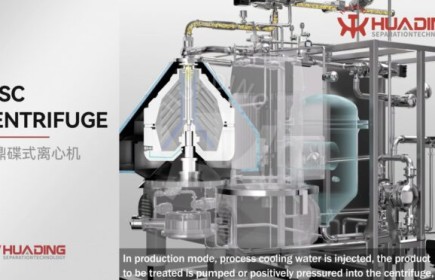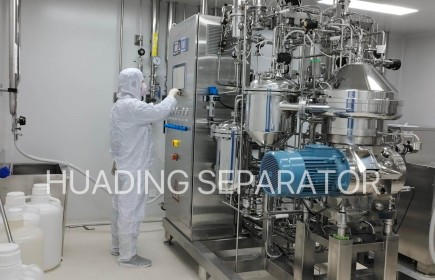2011年09月12日
Mechanical separation based on particle travel can be based strictly on gravitational forces (sedimentation) or can include centrifugal forces. The latter is particularly useful for fine particles when gravity alone is inadequate for sharp separation.
There are two broad categories of centrifugal separators:
- those where the fluid moves through a fixed device (cyclones, hydro clone, etc.)
- those where the system moves to create the centrifugal force (centrifuges)
These are all applications of “pressure diffusion” (if you remember that from Transport).
Before analyzing these systems, take a second to review the force balance on a particle:
and notice that the external force term includes either gravitational forces or centrifugal forces or both (also remember that the angular velocity has dimensions of radians/sec).
Cyclones
Cyclones (or cyclone separators) are typically used to remove mist or small particles from gas streams. Dust removal is a common application. When particles are entrained in a liquid, the same principles are used in a device called a hydro clone. The principles can also be used to separate two liquids in a centrifugal decanter.
Cyclones are typically conical in shape. Gas enters near the top through a tangential nozzle and moves in a spiral. As it moves the particles are thrown against the wall where they slide down for a collection, while the gas escapes through the top of the device.
The separation factor of a cyclone is defined as the ratio of centrifugal to gravitational forces:
In most cyclones the particles being separated are small enough that Stokes’ Law can be used to determine the drag force. This means that the force balance on a particle under centrifugal force becomes
Since the acceleration phase for the moving particle is fairly brief, the velocity can be treated as constant with respect to time (though NOT with respect to position) and the force balance solved for the radial velocity
which can in turn be expressed in terms of the gravitational terminal velocity and the tangential velocity
From this it can be seen (as expected) that the higher the terminal velocity the higher the radial velocity, and thus the easier the separation.
Centrifugation
In a centrifuge, the container spins to impart centrifugal force to the system. Although they have long been used for applications including cream separation and oil dehydration, they have become more important of late because of applications separating macromolecules, proteins, nucleic acids, etc. In particular, very high acceleration ultracentrifuges have been developed for extremely small particles.
In a typical centrifuge, the fluid enters from the bottom and leaves at the top. As the fluid moves, particles settle out. Particles near the wall are then removed.
If the diffusivity is negligible, the limiting behavior of a centrifuge is similar to gravity sedimentation with one big exception. In a centrifuge, the particle concentration is not the same throughout the fluid phase. Instead, it changes with time, since both the volume and acceleration increase radially. This phenomenon is called “radial dilution”.
Since the acceleration increases as the particle move away from the axis of rotation, so does the force. As a consequence, terminal velocity is never achieved. However, the radial “drift velocity” of a particle is relatively constant, so calculations are generally based on this.
The force balance and radial velocity calculations illustrated for cyclones also apply to centrifuges. Four radial distances will need to be defined.
First, set ra as the point where a particle begins to settle, and rb as the point it has reached after a time interval tr, which in turn is defined as the average time an element of fluid remains in the centrifuge. This will be recognized as the residence time, which can also be expressed as (Volume)/(Flow).
The other two distances are needed to describe the size of the fluid layer in the centrifuge. Define the inner radius of the fluid layer as r1 and the outer radius r2 (which is usually the wall).
Now, return to the radial velocity expression derived above. The velocity is the time derivative of the radial distance, so the expression can be integrated over the thickness of the fluid layer and the residence time to obtain:
This expression can then be solved for the residence time, or for the flowrate:
Separation in a centrifuge can be quantified in several ways. First, define a diameter “cutpoint”. This is the diameter of a particle that travels halfway through the fluid layer and thus halfway to the wall. To be removed, a partical must be at the wall, so rb = r2. A particle of cutpoint diameter must therefore have begun to settle at the halfway point, ra = (r1+r2)/2. Then,
and so if the flow through the centrifuge is greater than qcut, almost all particles larger than the cutpoint diameter will be removed, while the smaller particles will remain.
As a final calculation, we will derive the “Sigma” value for the centrifuge. This corresponds to the cross-sectional area of a gravity settler that would make the same separation as the centrifuge at the same volumetric feed rate. Hence,
if two centrifuges are to perform the same task.
Consider a system where the liquid layer inside the centrifuge is thin when compared to the total radius. This means that r1 and r2 are roughly the same, so the expressions for residence time, etc., are undefined. But we can still use the expression for the velocity at a given position. This radial distance of interest is that corresponds to the cutpoint or half the liquid thickness s, so the velocity must also be equal to this distance divided by the residence time, or
which has been rearranged in terms of the desired “Sigma” value and the terminal velocity under gravity.
- Foust, A.S. et al., Principles of Unit Operations (2nd Edition), John Wiley, 1980, pp. 620-629.
- McCabe, W.L., J.C. Smith, and P. Harriott, Unit Operations of Chemical Engineering (5th Edition), McGraw-Hill, 1993, pp. 31-32, 37-39, 1060-1072.
- Probstein, R.F., Physicochemical Hydrodynamics: An Introduction (2nd Edition), John Wiley, 1994, pp. 142-147.
--- 结尾 ---
Prev: Invitation for 54th CIPM
Next: 发酵液分离专家——华鼎离心机



